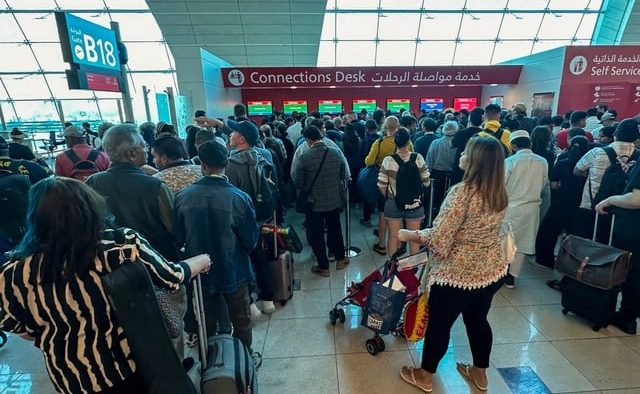As ‘extreme weather’ strikes the Gulf, aircraft are diverted from Dubai airport

Numerous inbound planes were diverted from Dubai’s main international airport on Tuesday due to the country’s widespread flooding caused by Tuesday’s intense rainfall in the United Arab Emirates.
The busiest international passenger airport in the world announced a “gradual resumption” more than two hours after confirming a halt to arrivals at 7:26 p.m. (1526 GMT).
In the midst of the storm’s mayhem, the airport—which had anticipated more than 100 airline arrivals on Tuesday night—took the equally rare action of momentarily stopping operations.
The financial hub of the Middle East, Dubai, has been rendered immobile by the intense rain that resulted in flooding in Bahrain and the UAE and killed eighteen people in Oman on Sunday and Monday.
Operations at the Dubai airport were halted for twenty-five minutes in the afternoon and then resumed. Social media users shared unverified photos of aircraft taxiing across an apron that was swamped with standing water.
Evening departure planes continued to operate, but they were beset by delays and cancellations. The airport’s access roads were severely inundated as well.
As the oil-rich Gulf state, more renowned for its desert environment and strong summer heat, reeled from the storm, similar images were replayed around Dubai and other parts of the United Arab Emirates.
The UAE and Oman, who hosted the COP28 UN climate meetings last year, have both issued earlier warnings that more flooding is expected as a result of global warming.
Expert in determining how individual extreme weather occurrences are affected by climate change, Friederike Otto, stated that global warming was probably involved.
According to Otto of the Imperial College London’s Grantham Institute for Climate Change, “it is highly likely that human-caused climate change made the deadly and destructive rain in Oman and Dubai heavier.”
According to pictures shared on social media, the iconic malls Dubai Mall and Mall of the Emirates both experienced flooding, while at least one Dubai Metro station had water up to the ankles.
There were many road collapses, severe flooding in residential areas, and numerous reports of leaks from windows, doors, and roofs.
All throughout the UAE, schools were closed, and on Wednesday, when further storms are predicted, they were likely to stay closed. The administration of Dubai has likewise allowed its staff to work remotely through Wednesday.
More than 80 millimeters (3.2 inches) of rain fell in certain inland parts of the United Arab Emirates in the 24 hours leading up to 8:00 am, almost the yearly average of roughly 100mm.
In a statement on X, previously Twitter, the National Center for Meteorology “urged residents to take all the precautions… and to stay away from areas of flooding and water accumulation”.
The weather forced a 24-hour postponement of the Asian Champions League football semi-final between Al Ain of the United Arab Emirates and Al Hilal of Saudi Arabia, which was scheduled to take place at Al Ain.
North-west of the United Arab Emirates, Bahrain, had been battered by lightning and thunder all night before experiencing intense rain and floods.
Nine-year-old Ali Hassan remarked, “I like to play in the rain, but for the first time it scares me,” while assisting his mother in removing water from outside their Manama, Bahraini capital.
After striking Oman, where they produced fatal floods and left many trapped, the storms moved on to the UAE, Bahrain, and portions of Qatar.
Two persons are still missing and there are now 18 fatalities, according to emergency officials who spoke with the official Oman News Agency on Tuesday. The corpse of a kid was found.
The news agency said on Sunday that nine pupils and three adults perished when their cars were carried away by flash floods.

I am a dedicated student currently in my seventh semester, pursuing a degree in International Relations. Alongside my academic pursuits, I am actively engaged in the professional field as a content writer at the Rangeinn website.








